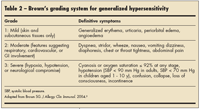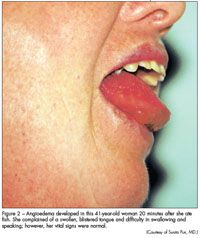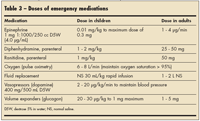- Clinical Technology
- Adult Immunization
- Hepatology
- Pediatric Immunization
- Screening
- Psychiatry
- Allergy
- Women's Health
- Cardiology
- Pediatrics
- Dermatology
- Endocrinology
- Pain Management
- Gastroenterology
- Infectious Disease
- Obesity Medicine
- Rheumatology
- Nephrology
- Neurology
- Pulmonology
Anaphylaxis: Commonsense Ways to Reduce Risk
The term “anaphylaxis” (without protection) was first coined by Richet and Portier in 1902 to describe a “supersensitivity” reaction they observed while attempting to produce tolerance to sea anemone venom in dogs. During their experiments, an unforeseen event occurred.
The term “anaphylaxis” (without protection) was first coined by Richet and Portier in 1902 to describe a “supersensitivity” reaction they observed while attempting to produce tolerance to sea anemone venom in dogs. During their experiments, an unforeseen event occurred. Dogs who had completely recovered from initial doses of the toxic venom became violently ill and died a few minutes after administration of a second, very small dose.1
More than a hundred years later, anaphylaxis is still not completely understood. However, it is often described as a potentially fatal, systemic, type 1 hypersensitivity reaction that occurs in sensitized persons and results in cardiovascular, GI, respiratory, and mucocutaneous manifestations.2,3
Similar clinical reactions that mimic anaphylaxis, but are not IgEmediated, are currently described as “anaphylactoid” responses. This terminology is now being revised by a committee of the World Allergy Organization. In our discussion, anaphylactoid responses will be referred to as nonallergic (nonimmunologic) anaphylaxis.4
Our focus here is on the early recognition and prompt treatment of anaphylaxis.
INCIDENCE
Although diagnostic codes for anaphylaxis were introduced in 2003, they are often underused, which has resulted in underreporting.5 Thus, epidemiological studies of anaphylaxis have been difficult to conduct. In 2001, Neugut and colleagues6 based their estimate of anaphylaxis incidence on a meta-analysis of reports of reactions to foods, drugs, latex, and insect stings. They found that between 3.3 and 4.3 million Americans were at risk for an anaphylactic event and that of those susceptible persons, 12% to 16% were at risk for a fatal reaction. The foods most commonly implicated in fatal reactions were peanuts and shellfish.6
In a telephone survey, more than 6 million persons reported allergy to seafood, with a large majority specifically identifying shellfish. Re-actions were reported to be severe in many cases. The authors of the study point out, however, that these events may include not only IgE based but also nonallergic (eg, resulting from toxic or infectious contaminants) reactions.7
In the United States, about 1.5 million persons are allergic to peanuts or tree nuts, which account for the majority of severe or fatal reactions. Other foods implicated in severe reactions include fish, eggs, milk, soy, and wheat.8TRIGGERS
In addition to certain foods, insect stings, exercise, and latex exposure can trigger anaphylaxis in sensitized persons. Food reactions are the most common form of anaphylaxis, especially in children.
Nonallergic reactions are most often associated with radiocontrast media, NSAIDs, and narcotic analgesics.9 However, virtually any foreign substance can trigger an anaphylactic response.5
Exercise-induced anaphylaxis can be difficult to diagnose, and the exact mechanisms are poorly understood. Many types of exercise have been implicated, including jogging, walking, tennis, and dancing. In the majority of cases, prior food ingestion seems to contribute to anaphylactic events.5
Latex sensitivity has become increasingly prevalent in the last 2 decades. The institution of universal precautions in the late 1980s has made the use of latex gloves commonplace. In addition, many household products contain latex, making exposure almost unavoidable. Patients who require multiple surgical procedures (eg, those with spina bifida) and many health care workers are at higher risk because of repetitive exposure. Certain fruits and vegetables (bananas, kiwis, avocados, and chestnuts) cross-react with latex, and persons can be sensitized to these foods as a consequence of their latex sensitivity.9RISK FACTORS
Persons with atopy are at increased risk for anaphylaxis. Furthermore, those who have had anaphylaxis to one substance may also be hypersensitive to other substances. Some researchers have theorized that these persons have a lower threshold for degranulation of mast cells and basophils, thereby making anaphylactic responses more common.6
Case reports of anaphylaxis to foods strongly suggest that the presence of asthma contributes significantly to fatal outcomes. The bronchospasm associated with the anaphylactic response can be difficult to reverse in many cases, especially if the administration of epinephrine is delayed. Unfortunately, chest tightness may be misinterpreted as asthma symptoms, rather than as a manifestation of anaphylaxis. This misunderstanding further delays appropriate treatment and contributes to poor outcomes.8,10
Persons who take β-blockers for control of hypertension or other medical conditions are much more likely to experience a severe anaphylactic event because the blockage of β-receptors decreases the effectiveness of epinephrine.2 Angiotensin-converting enzyme (ACE) inhibitors can also make anaphylactic reactions more difficult to treat. This results from the blocking of the body’s normal compensatory mechanisms (renin-angiotensin- aldosterone) in response to decreased circulating blood volume.9PATHOPHYSIOLOGY

Anaphylaxis is caused by the rapid, IgE-mediated release (degranulation) of potent mediators, such as histamine, from tissue mast cells and peripheral basophils (Figure 1). The release of mediators leads to target organ responses. Although the severity of the symptoms can vary depending on the implicated trigger, anaphylaxis involves multiple organ systems and is usually characterized by mucocutaneous symptoms, respiratory insufficiency, and hemodynamic changes.5
IgE crosslinking initiates the degranulation of mast cells and basophils, releasing various chemical mediators and chemotactic agents that drive the subsequent reaction. These include histamine, tryptase, prostaglandin D2 (PGD2), and cysteinyl leukotrienes, predominantly LTC4.
Histamine is believed to be the primary mediator of anaphylactic shock.9 Histamine activates both H1 and H2 receptors. H1 receptor activation results in pruritus, rhinorrhea, and bronchospasm, whereas H2 receptor activation contributes to flushing, hypotension, and headache. Studies have shown histamine levels correlate with the severity and persistence of hemodynamic changes and GI symptoms. PGD2 promotes bronchospasm and vasodilatation. LTC4 is converted into the leukotrienes responsible for hypotension, bronchospasm, and mucus secretion. These substances also act as chemotactic agents, recruiting eosinophils and neutrophils. The complement system, clotting cascade, and other complex compensatory mechanisms are also active during anaphylaxis.9
Because of its exclusive presence in human mast cells, the enzyme tryptase is a unique marker for anaphylactic events. Specifically, elevated beta-tryptase levels have shown a positive correlation with anaphylaxis severity.9
Fatal anaphylactic events often result from cardiac arrest as the primary cause of death. Some researchers believe that chemical mediators associated with anaphylaxis affect the myocardial tissue directly and may contribute to myocardial insufficiency. Cardiac arrest may also result from the hemodynamic changes that occur during anaphylaxis: more than half of the circulating blood volume pools in the peripheral circulation or enters the interstitial space, leaving the heart with no blood to pump (“empty heart syndrome”).2,9
CLINICAL PRESENTATION

Symptoms. The symptoms of anaphylaxis can vary widely between patients as well as between different episodes in the same patient. Most researchers divide symptoms into mucocutaneous, respiratory, cardiovascular, and GI. In addition, some patients describe a “feeling of impending doom” (Table 1).2
Anaphylactic reactions can also be biphasic; after the initial episode, patients have an intermediate phase of stability followed by symptom recurrence, which is often more severe and refractory to treatment than the immediate reaction.
Lee and Greenes11 performed a retrospective analysis of 108 cases of anaphylaxis in children and found that 6% demonstrated a biphasic pattern. Sampson and colleagues10 examined a group of 13 children with food allergy triggers and found a 23% recurrence. Korenblat and associates12 reported that 35% of a group of 105 patients required multiple doses of epinephrine because of recurrent symptoms.
The onset of symptoms can vary and is often determined by the causative agent. Food reactions can occur within minutes of ingestion. Insect stings cause rapid and often severe reactions; 96% of fatal reactions occur within the first 30 minutes.
Classification. Several attempts at classification of anaphylaxis severity have been made. Brown3 retrospectively analyzed 1149 cases over a 9-year period and designed a classification system based on severity (Table 2). Many experts consider urticaria and angioedema (Figure 2) to be the most common manifestations of anaphylaxis, although they may be absent, even in severe cases. The next most common findings are respiratory symptoms, followed by dizziness, unconsciousness, and GI symptoms.2 The rapidity of onset of symptoms is directly correlated with severity.6

DIAGNOSIS

Anaphylaxis remains primarily a clinical diagnosis. Successful outcomes often depend on early recognition of the signs and symptoms of anaphylaxis, including prompt evaluation of the respiratory and cardiovascular systems. It is equally important to obtain (after the patient is stabilized) a detailed history, including the time the event started, what treatment-if any-was given, and the identification of precipitating factors. In the history taking, ask the patient about atopy as well as asthma; both are important risk factors. Vasovagal reactions can mimic anaphylaxis; however, the lack of cutaneous manifestations usually distinguishes this phenomenon from anaphylaxis.13
Measurement of serum tryptase, as well as plasma and urinary histamine metabolites (N-methylhistamine), can help distinguish anaphylaxis, but the timing of these tests is important. Histamine levels should be measured between 10 minutes and 1 hour after the onset of symptoms. Serum tryptase levels are elevated for 1 to 6 hours after the onset of the event and can indicate that anaphylaxis has occurred.14 Serial measurements of tryptase levels may be the most helpful.15 Although no specific laboratory tests can identify anaphylaxis with complete certainty, in some retrospective analyses, postmortem serum tryptase levels of greater than 50 U/L have shown specificity for anaphylaxis.9TREATMENTEpinephrine. Prompt administration of epinephrine is imperative in the treatment of all types of anaphylaxis.5 Recent evidence indicates that the best method of administration appears to be intramuscular (vastus lateralis) rather then subcutaneous (deltoid). This recommendation is based on the results of studies conducted with children and young adults at risk for anaphylaxis. The intramuscular route demonstrated a statistically significant higher peak plasma concentration than the subcutaneous route. This difference was attributed to the large muscle size and rich blood supply of the vastus lateralis.16
Unfortunately, epinephrine can sometimes be ineffective in the treatment of anaphylaxis. The reasons include incorrect administration, delay in administration, and failure to notice that the medication in the autoinjector has expired. Studies that examined the bioavailability of epinephrine show an inverse relationship between the measurable content of epinephrine and the length of time past the expiration date.16
Currently available fixed doses of epinephrine pose an additional dilemma for health care providers and patients and their parents. It is impossible to give children of all weights the specific recommended dose of 0.01 mg/kg from the autoinjectors currently available (EpiPen, EpiPen Jr, Twinject 0.15 and 0.30 mg). One study showed that children who received a higher than recommended dose had hypertension, pallor, tremor, anxiety, and palpitations.16
Despite these findings, continue to counsel patients to maintain a current prescription of the most appropriate dose of epinephrine at all times, since in most cases the benefits clearly outweigh the risks. In their retrospective review of cases of children with fatal or near-fatal food reactions, Sampson and colleagues10 found that every death studied was associated with the delay or absence of epinephrine administration.
Due to the fact that many patients are highly apprehensive about injections, other routes of epinephrine administration have been explored. Unfortunately, inhaled epinephrine has not proved effective for symptoms other than those associated with the respiratory system. Oral administration is completely ineffective.5
Because sublingual administration of nitroglycerin is effective, studies are presently being conducted to examine the feasibility of delivering epinephrine by this route.16Antihistamines. Histamine plays a significant role in the pathophysiology of anaphylaxis; thus, antihistamines have been included in most treatment guidelines. H1 receptor antagonists relieve cutaneous symptoms but have little effect on respiratory or GI symptoms. Orally ingested antihistamines can take 60 minutes to achieve a measurable clinical response.

Furthermore, the use of antihistamines as first-line treatment, although common, may not sufficiently protect the patient. In many cases of anaphylaxis, initial cutaneous symptoms are only the first manifestation and do not accurately predict the severity of the reaction, especially in food allergy exposure, when respiratory or cardiac arrest can occur within 30 minutes.8
When clinically appropriate, the current recommendation is for diphenhydramine to be administered parenterally as a second-line measure to epinephrine. Some studies have shown that ranitidine, in combination with diphenhydramine, is more effective than diphenhydramine given alone (Table 3).13Additional interventions. Patients must be evaluated by a health care provider as soon as possible after epinephrine is administered. In the acute care setting, additional intervention may include oxygen administration, establishment of venous access, administration of replacement fluids and, when necessary, use of volume expanders and vasopressor agents. Keep in mind, however, that pressor agents may not be as effective as volume replacement and volume expanders because of the release of potent vasoconstrictors (catecholamines, angiotensin II) in response to the drop in circulating blood volume.9
Positioning of patients during anaphylactic events can affect outcomes. In a retrospective analysis of 214 cases of fatal anaphylaxis, Pumphrey17 reported overwhelming evidence that upright positioning during anaphylactic shock could contribute to sudden death. Massive fluid shifts markedly affect circulating blood volume and can result in cardiac failure. Therefore, during treatment for anaphylaxis, the supine position, with the feet elevated, is highly recommended.
All patients should be observed for at least 4 hours because the vast majority of biphasic reactions occur within that time frame.9,11
Desensitization can provide significant protection against insect sting sensitivity and is curative in many patients. Golden and associates18 reported a marked decrease in the incidence of moderate to severe reactions to insect stings among children up to 20 years after immunotherapy had been completed. The children had been treated for 3 to 5 years. The response in adults may be slightly different. Retrospective analysis of 50 adults showed that 10% had relapsed after the same length of treatment.
EDUCATION
After an anaphylactic episode has occurred, it is imperative that patients have a clear understanding of the events that preceded it. Even though one event does not predict the next with certainty, a history of anaphylaxis is a significant predictor of additional episodes.6
Further workup may be necessary. Consider referral to an allergy specialist for a thorough evaluation for every patient who has experienced a life-threatening episode of anaphylaxis.13 If necessary, an allergist can administer immunotherapy for insect stings, which has been found to be very effective in preventing future severe reactions. This option should be discussed with the patient.
If food is identified as the causative agent, education about avoidance and management of an accidental ingestion is crucial.13 Organizations such as the Food Allergy and Anaphylaxis Network (FAAN) (www.foodallergy.com) can often be invaluable to patients and their families. The FAAN can provide specific information about how to read a food label carefully, and it also offers resources to educate teachers and other caregivers about the management of anaphylaxis. Patients with latex allergy can find support from the American Latex Association (www.latexallergyresources.org).15
Management of triggers such as drugs and radiocontrast media involves avoidance, and this approach should be clearly communicated to the patient. MedicAlert bracelets (www.MedicAlert.org) are extremely helpful for patients with food and drug sensitivities as well those with a radiocontrast sensitivity.9
Provide all patients at risk for anaphylaxis with a written action plan. A sample anaphylaxis emergency action plan is available on the Web site of the American Academy of Allergy, Asthma & Immunology (www.aaaai.org/members/resources/anaphylaxis_toolkit/ action_plan.pdf). In addition, family members and friends should be educated about anaphylaxis recognition and epinephrine administration.
References:
REFERENCES:
1. Richet C.
Anaphylaxis
. Abingdon, UK: OxfordHistorical Books; 1989:4.
2. Kemp SF, Lockey RF. Anaphylaxis: a review ofcauses and mechanisms.
J Allergy Clin Immunol
.2002;110:341-348.
3. Brown SG. Clinical features and severity gradingof anaphylaxis.
J Allergy Clin Immunol
. 2004;114:371-376.
4. Johansson SG, Bieber T, Dahl R, et al. Revisednomenclature for allergy for global use: Report ofthe Nomenclature Review Committee of the WorldAllergy Organization, October 2003.
J Allergy ClinImmunol
. 2004;113:832-836.
5. Sampson HA, Muñoz-Furlong A, Bock SA, et al.Symposium on the definition and management ofanaphylaxis: summary report.
J Allergy Clin Immunol
.2005;115:584-591.
6. Neugut AI, Ghatak AT, Miller RL. Anaphylaxis inthe United States: an investigation into its epidemiology.Arch Intern Med. 2001;161:15-21.
7. Sicherer SH, Muñoz-Furlong A, Sampson HA.Prevalence of seafood allergy in the United Statesdetermined by a random telephone survey.
J AllergyClin Immunol
. 2004;114:159-165.
8. Bock SA, Muñoz-Furlong A, Sampson HA. Fatalitiesdue to anaphylactic reactions to foods.
J AllergyClin Immunol
. 2001;107:191-193.
9. Johnson RF, Peebles RS. Anaphylactic shock:pathophysiology, recognition, and treatment.
SeminRespir Crit Care Med
. 2004;25:695-703.
10. Sampson HA, Mendelson L, Rosen JP. Fatal andnear-fatal anaphylactic reactions to food in childrenand adolescents.
N Engl J Med
. 1992;327:380-384.
11. Lee JM, Greenes DS. Biphasic anaphylactic reactionsin pediatrics. Pediatrics. 2000;106:762-766.
12. Korenblat P, Lundie MJ, Dankner RE, Day JH.A retrospective study of epinephrine administrationfor anaphylaxis: how many doses are needed?
AllergyAsthma Proc
. 1999;20:383-386.
13. Joint Task Force on Practice Parameters; AmericanAcademy of Allergy, Asthma and Immunology;American College of Allergy, Asthma and Immunology;Joint Council of Allergy, Asthma and Immunology.The diagnosis and management of anaphylaxis: anupdated practice parameter.
J Allergy Clin Immunol
.2005;115(3, suppl 2):S483-S523.
14. Lin RY, Schwartz LB, Curry A, et al. Histamineand tryptase levels in patients with acute allergicreactions: an emergency department-based study.
J Allergy Clin Immunol
. 2000;106:65-71.
15. Simons FE. Anaphylaxis, killer allergy: longtermmanagement in the community.
J Allergy ClinImmunol.
2006;117:367-377.
16. Simons FE. First-aid treatment of anaphylaxisto food: focus on epinephrine.
J Allergy Clin Immunol
.2004;113:837-844, 1039.
17. Pumphrey RS. Fatal posture in anaphylacticshock.
J Allergy Clin Immunol
. 2003;112:451-452.
18. Golden DB, Kagey-Sobotka A, Norman PS, etal. Outcomes of allergy to insect stings in children,with and without venom immunotherapy.
N EnglJ Med.
2004;351:668-674.
19. Sicherer SH. How to recognize and manage anaphylaxis:the key points.
J Respir Dis Pediatricians
.2003;5:191-198.
